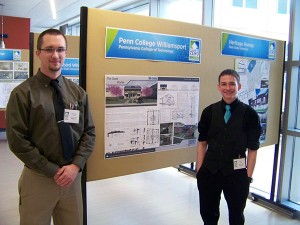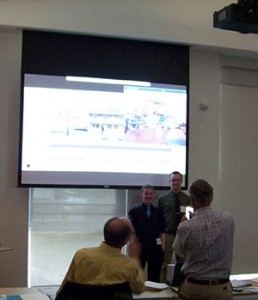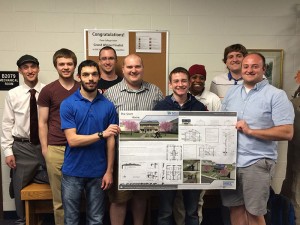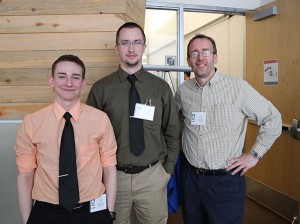Penn College Among National Finalists in Home-Design Competition
Wednesday, May 6, 2015
A team of Pennsylvania College of Technology students was among the grand-prize finalists at the second annual “Race to Zero Student Design Competition” held recently at the National Renewable Energy Labs in Golden, Colorado.
The U.S. Department of Energy sponsors the competition, which challenges college and university students to design “zero energy-ready homes” – high-performance homes so energy-efficient that they completely offset their energy consumption through electricity produced by renewable sources.
 A Passive House rated duplex designed for Habitat for Humanity was presented by Penn College students Dustin C. Bailey, of Petersburg, and Christopher G. Master, of Cranberry, enrolled in building science and sustainable design: architectural technology concentration. The project is slated to be built next year on Scott Street in Williamsport’s West End.
A Passive House rated duplex designed for Habitat for Humanity was presented by Penn College students Dustin C. Bailey, of Petersburg, and Christopher G. Master, of Cranberry, enrolled in building science and sustainable design: architectural technology concentration. The project is slated to be built next year on Scott Street in Williamsport’s West End.
Traveling with Robert A. Wozniak, associate professor of architectural technology and team co-adviser, they were joined electronically by teammates who assisted with answering questions from the national experts who comprised the judges’ panel.
The Penn College team, among 33 entries from 27 institutions in the United States and Canada, was ultimately among four Grand Winner finalists. The others, indicative of the caliber of competition in which Penn College stood tall, were Appalachian State University, Carnegie Mellon University and the University of Illinois at Urbana-Champaign. The competition was won by the University of Minnesota.
 “What a success, not only for the students and Penn College, but also for Habitat for Humanity,” said Marc E. Bridgens, dean of construction and design technologies. “The benefits of their hard work in preparing for this competition go beyond personal pride. Their accomplishments will be seen within the community.”
“What a success, not only for the students and Penn College, but also for Habitat for Humanity,” said Marc E. Bridgens, dean of construction and design technologies. “The benefits of their hard work in preparing for this competition go beyond personal pride. Their accomplishments will be seen within the community.”
Those contributing by videoconferencing were Samantha R. Callender, of Baldwin, New York; Michael J. Fonti, of Wayne, New Jersey; Peter L. Gauthier, of Newville, building science and sustainable design; Justin D. Iman, of Zionsville; Adam T. Knoebel, of Montoursville; Zachary T. Robey, of Williamsport; and Matthew R. Vent, of Drexel Hill.
 All are majoring in building science and sustainable design: architectural technology concentration, except Gauthier (building science and sustainable design), Robey (building automation technology) and Vent (residential construction technology and management: building construction technology concentration).
All are majoring in building science and sustainable design: architectural technology concentration, except Gauthier (building science and sustainable design), Robey (building automation technology) and Vent (residential construction technology and management: building construction technology concentration).
“I was amazed by how many graduate and Ph.D. students were competing. Not very many undergrads were represented!” Wozniak said. “The judges appeared to be very pleased as they kept nodding at what was presented – and especially at how the questions were answered, either in person or by those ‘virtually’ in Williamsport.”
 So impressive was their presentation that the students have been invited to present a paper on their project at this summer’s American Solar Energy Society conference at Penn State.
So impressive was their presentation that the students have been invited to present a paper on their project at this summer’s American Solar Energy Society conference at Penn State.
The interdisciplinary team produced a full set of documentation, working together to make decisions based on neighborhood concerns, Habitat requirements, high performance standards and building science fundamentals.
 “We are thrilled that the team earned top recognition at the competition,” said Dorothy J. Gerring, associate professor of architectural technology and faculty co-adviser for the team. “It is exciting that our students are able to apply their knowledge base to an affordable project that will be built to one of the highest performance standards – right near the campus.”
“We are thrilled that the team earned top recognition at the competition,” said Dorothy J. Gerring, associate professor of architectural technology and faculty co-adviser for the team. “It is exciting that our students are able to apply their knowledge base to an affordable project that will be built to one of the highest performance standards – right near the campus.”
For more information about Penn College’s architectural technology majors, call the School of Construction & Design Technologies at 570-327-4518.
For more about Penn College, email the Admissions Office or call toll-free 800-367-9222.
The U.S. Department of Energy sponsors the competition, which challenges college and university students to design “zero energy-ready homes” – high-performance homes so energy-efficient that they completely offset their energy consumption through electricity produced by renewable sources.
 A Passive House rated duplex designed for Habitat for Humanity was presented by Penn College students Dustin C. Bailey, of Petersburg, and Christopher G. Master, of Cranberry, enrolled in building science and sustainable design: architectural technology concentration. The project is slated to be built next year on Scott Street in Williamsport’s West End.
A Passive House rated duplex designed for Habitat for Humanity was presented by Penn College students Dustin C. Bailey, of Petersburg, and Christopher G. Master, of Cranberry, enrolled in building science and sustainable design: architectural technology concentration. The project is slated to be built next year on Scott Street in Williamsport’s West End.Traveling with Robert A. Wozniak, associate professor of architectural technology and team co-adviser, they were joined electronically by teammates who assisted with answering questions from the national experts who comprised the judges’ panel.
The Penn College team, among 33 entries from 27 institutions in the United States and Canada, was ultimately among four Grand Winner finalists. The others, indicative of the caliber of competition in which Penn College stood tall, were Appalachian State University, Carnegie Mellon University and the University of Illinois at Urbana-Champaign. The competition was won by the University of Minnesota.
 “What a success, not only for the students and Penn College, but also for Habitat for Humanity,” said Marc E. Bridgens, dean of construction and design technologies. “The benefits of their hard work in preparing for this competition go beyond personal pride. Their accomplishments will be seen within the community.”
“What a success, not only for the students and Penn College, but also for Habitat for Humanity,” said Marc E. Bridgens, dean of construction and design technologies. “The benefits of their hard work in preparing for this competition go beyond personal pride. Their accomplishments will be seen within the community.”Those contributing by videoconferencing were Samantha R. Callender, of Baldwin, New York; Michael J. Fonti, of Wayne, New Jersey; Peter L. Gauthier, of Newville, building science and sustainable design; Justin D. Iman, of Zionsville; Adam T. Knoebel, of Montoursville; Zachary T. Robey, of Williamsport; and Matthew R. Vent, of Drexel Hill.
 All are majoring in building science and sustainable design: architectural technology concentration, except Gauthier (building science and sustainable design), Robey (building automation technology) and Vent (residential construction technology and management: building construction technology concentration).
All are majoring in building science and sustainable design: architectural technology concentration, except Gauthier (building science and sustainable design), Robey (building automation technology) and Vent (residential construction technology and management: building construction technology concentration).“I was amazed by how many graduate and Ph.D. students were competing. Not very many undergrads were represented!” Wozniak said. “The judges appeared to be very pleased as they kept nodding at what was presented – and especially at how the questions were answered, either in person or by those ‘virtually’ in Williamsport.”
 So impressive was their presentation that the students have been invited to present a paper on their project at this summer’s American Solar Energy Society conference at Penn State.
So impressive was their presentation that the students have been invited to present a paper on their project at this summer’s American Solar Energy Society conference at Penn State.The interdisciplinary team produced a full set of documentation, working together to make decisions based on neighborhood concerns, Habitat requirements, high performance standards and building science fundamentals.
 “We are thrilled that the team earned top recognition at the competition,” said Dorothy J. Gerring, associate professor of architectural technology and faculty co-adviser for the team. “It is exciting that our students are able to apply their knowledge base to an affordable project that will be built to one of the highest performance standards – right near the campus.”
“We are thrilled that the team earned top recognition at the competition,” said Dorothy J. Gerring, associate professor of architectural technology and faculty co-adviser for the team. “It is exciting that our students are able to apply their knowledge base to an affordable project that will be built to one of the highest performance standards – right near the campus.”For more information about Penn College’s architectural technology majors, call the School of Construction & Design Technologies at 570-327-4518.
For more about Penn College, email the Admissions Office or call toll-free 800-367-9222.
